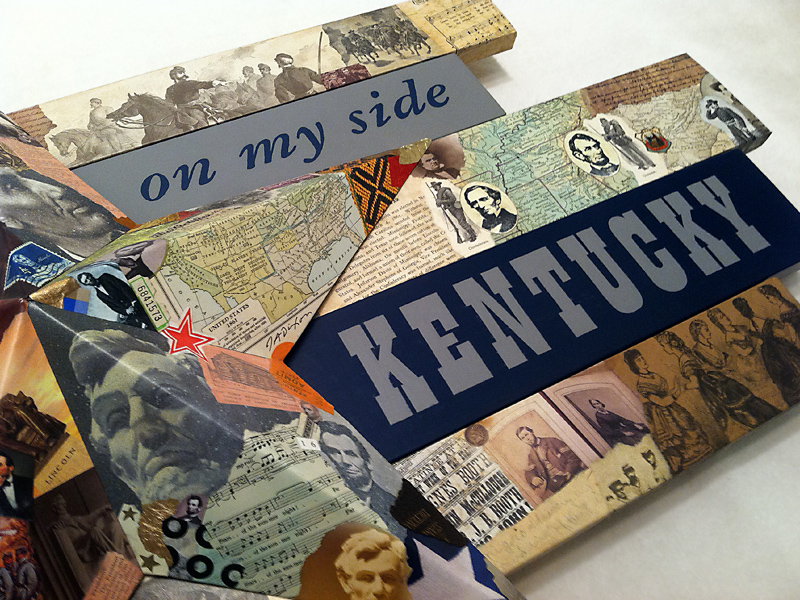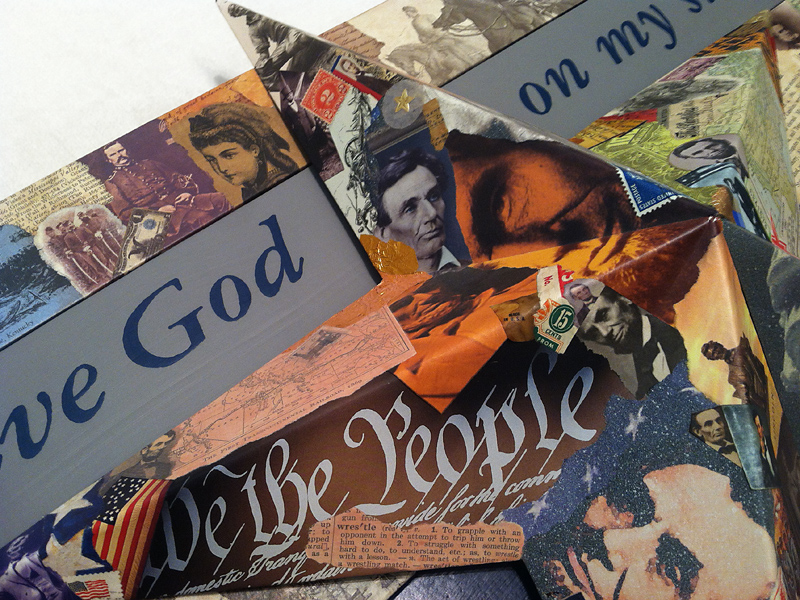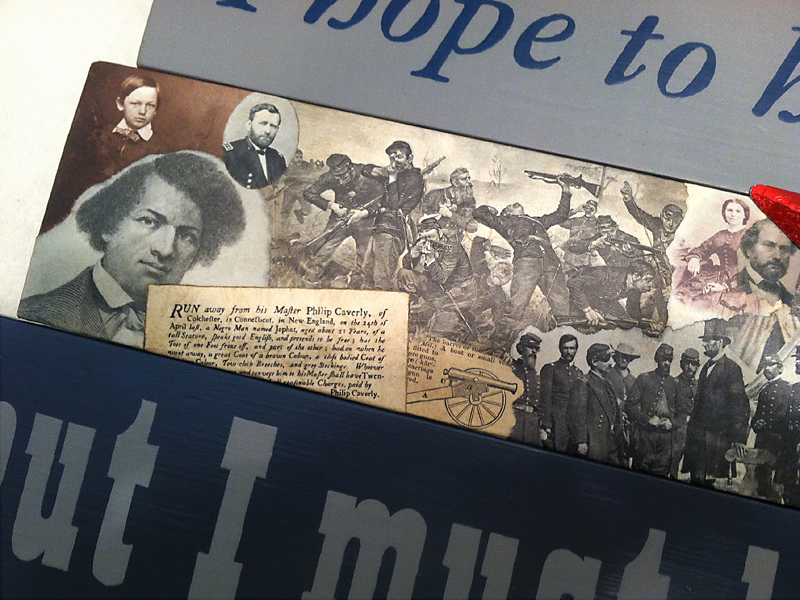“I think to lose Kentucky is nearly the same as to lose the whole game. Kentucky gone, we cannot hold Missouri, nor Maryland. These all against us, and the job on our hands is too large for us. We would as well consent to separation at once, including the surrender of this capitol.”
— Abraham Lincoln, 1861
I am constantly experimenting, because I find it difficult to pluck a coherent idea from a “cold start,” and so I cultivate a habit of collage experimentation to preserve a state of receptivity and to invite the uncanny “synchronicities” from which a more rational concept can be refined. More often than not, there are no distinct memories associated with the genesis of an idea. It is unusual, therefore, to have a clear recollection of the creative lineage for I Must Have Kentucky, currently on display as part of 225: Artists Celebrate Kentucky’s History.
I was stumped about how to respond when a call to artists from curator Gwen Heffner announced an exhibition to observe Kentucky’s 225th birthday. I thought about the history of my own town (Danville, the first capital of the state), about the The Kentucky Documentary Photographic Project, about the story of tobacco growing families in Kentucky, and about the great Kentucky abolitionists. There were so many fascinating subjects, but none of them sparked a visual flame in my imagination. When I shared my befuddlement with Dana, my “partner in all things,” she suggested I consider doing something with Star of Abraham, an artifact I made in 2009 for the bicentennial of the 16th president’s birth. 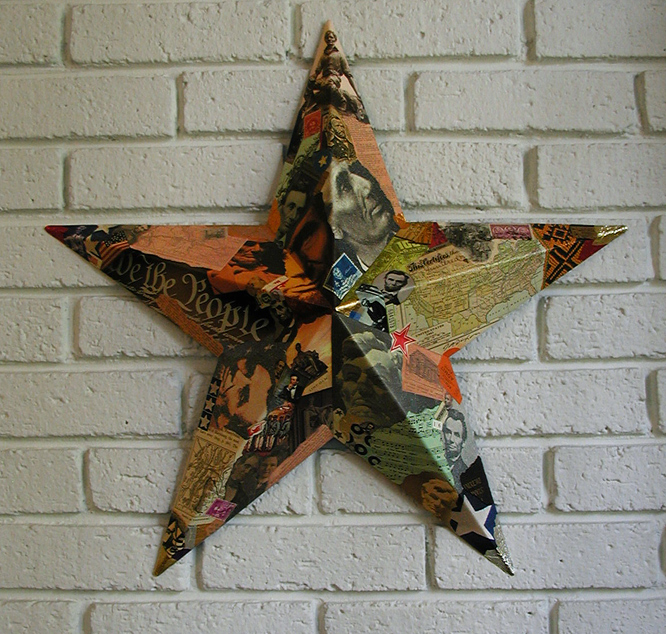 The bulk of my collected Lincoln images had been exploited to cover a salvaged metal star. To produce a collage tribute to the martyred leader with a folk-art quality seemed a technique appropriate to the occasion, and it was still in my studio, generating little interest from visitors. I liked the notion of using it as a “found object” in a larger assemblage, but there needed to be more to it than that. The solution finally hit me on a drive to our family farm, when I turned off the radio and focused on the rolling “knobs” that surrounded me: Lincoln’s famous declaration about his home state during the Civil War!
The bulk of my collected Lincoln images had been exploited to cover a salvaged metal star. To produce a collage tribute to the martyred leader with a folk-art quality seemed a technique appropriate to the occasion, and it was still in my studio, generating little interest from visitors. I liked the notion of using it as a “found object” in a larger assemblage, but there needed to be more to it than that. The solution finally hit me on a drive to our family farm, when I turned off the radio and focused on the rolling “knobs” that surrounded me: Lincoln’s famous declaration about his home state during the Civil War!
I got down a flurry of thumbnail concepts in my journal when I arrived at my destination. It was barely necessary to ever look at them again, because the development toward a final idea took on a momentum of its own. I realized I could enlarge my Lincoln theme with additional artisanship to include the importance of Kentucky in his strategic thinking. A design took shape in my sketches, and I searched my stash for images that would do justice to the “brother against brother, family against family” character of the conflict in a state that gave birth to the presidents of each warring side.
The expanded mixed-media construction is created from recycled materials — found ingredients include salvaged wood and metal, plus discarded books, magazines, maps, and mailed promotions. My lettering is hand painted with acrylics. 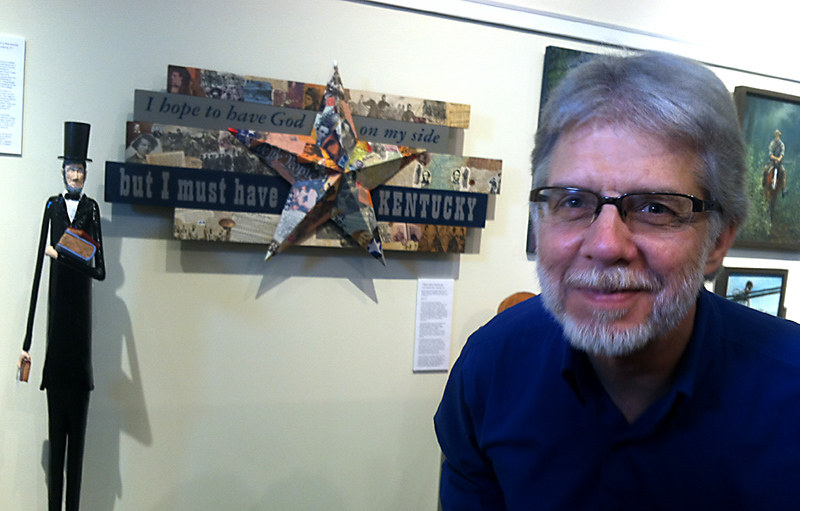 Obviously, the dimensional star represents Abraham Lincoln. The five horizontal bands signify the final years of his life and the impact his decisions had on Kentucky and the United States during that time. Among the individuals featured are Kentucky native Jefferson Davis, Lincoln’s rival in war, and Senator Stephen A. Douglas, his rival in peace, plus Lexington native Mary Todd, her sons Willie and Robert, Munfordville native Simon B. Buckner, Frederick Douglass, U.S. Grant, Clara Barton, John Hunt Morgan, and others. Also represented: soldiers, their ladies, Kentucky coal miners, and the decisive Battle of Perryville.
Obviously, the dimensional star represents Abraham Lincoln. The five horizontal bands signify the final years of his life and the impact his decisions had on Kentucky and the United States during that time. Among the individuals featured are Kentucky native Jefferson Davis, Lincoln’s rival in war, and Senator Stephen A. Douglas, his rival in peace, plus Lexington native Mary Todd, her sons Willie and Robert, Munfordville native Simon B. Buckner, Frederick Douglass, U.S. Grant, Clara Barton, John Hunt Morgan, and others. Also represented: soldiers, their ladies, Kentucky coal miners, and the decisive Battle of Perryville.
The artwork commemorates our Commonwealth during 1860 to 1864, the most tumultuous period in its history. At the center of those pivotal years is the towering figure of its most illustrious native son, who encapsulated the significance of the border state to the cause of national unity when he reputedly declared:
“I hope to have God on my side, but I must have Kentucky”.
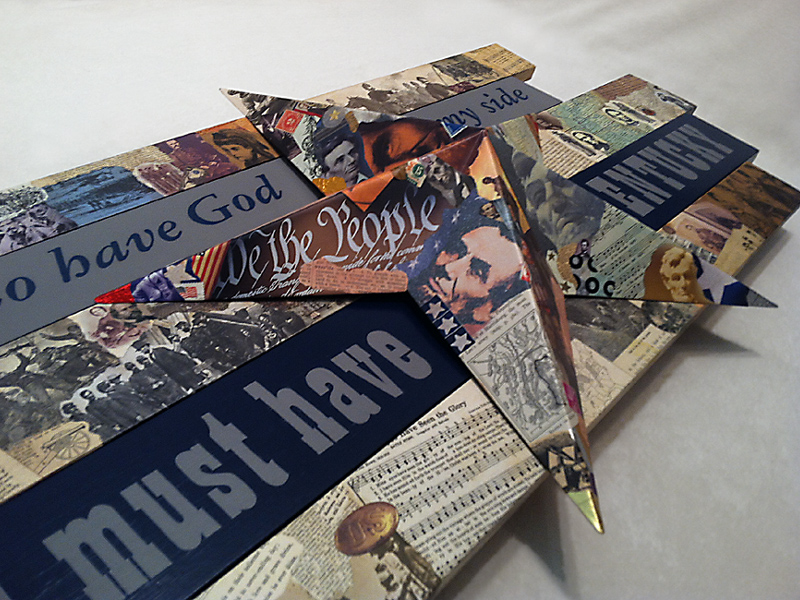
I secured the existing ‘Star of Abraham’ to a construction of five salvaged
wood planks, which alternates hand-painted lettering with my typical collage
treatment. My Lincoln artifact had finally found a fitting context.
I long have found interesting that Kentucky had given birth to both
presidential leaders in the national conflict, and I devoted a section of my
composition to that inexplicable fact.
Border-state Kentuckians were divided when war broke out. Munfordville
native Simon B. Buckner attempted to enforce its neutrality before accepting
a Confederate commission. He led troops at the strategic Battle of Perryville
in 1862, and later became a scandal-plagued governor of the Commonwealth.
One of my favorite spots in the piece: Lincoln’s boy Willie, U.S. Grant, a young
Frederick Douglass as a free man next to a slaveholder’s advertisement,
a superb wood engraving of combat, Clara Barton, Samuel Colt, and an image
of the Commander in Chief that indicates his unusual height.
Thanks for reading such a long entry. I invite you to register and comment here. Let me know what you think. If anything bugs you, constructive criticism is encouraged!
